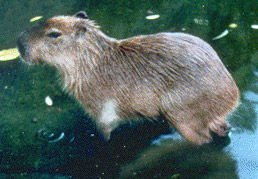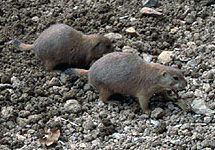Introduction to the Rodentia
 Lodgepole Chipmunk. Photo by Dr. Lloyd Glenn Ingles © 1999 California Academy of Sciences. |
The single largest group of mammals is the Rodentia. Most non-flying mammals are rodents: there are about 1,500 living rodent species (out of about 4,000 living mammals overall). Most people are familiar with mice, rats, hamsters, and guinea pigs, which are commonly kept as pets. The Rodentia also includes beavers, muskrats, porcupines, woodchucks, chipmunks, squirrels, prairie dogs, marmots, chinchillas, voles, lemmings, and many others. (Incidentally, the Rodentia does not include rabbits; rabbits differ from rodents in having an extra pair of incisors and in other skeletal features. Rabbits, hares, and a few other species make up the Lagomorpha. Shrews, moles and hedgehogs are also not rodents; they are classified in the Mammal order Eulipotyphla.)
Rodents are found native on all continents except Antarctica. One particular family of rodents, the Muridae, contains over 1100 species: over a quarter of all mammal species are rats, mice, voles, muskrats, lemmings, hamsters, gerbils, and other members of the Muridae. However, rodents show perhaps their greatest diversity of form in South America, which was an isolated continent for much of the Cenozoic. A few of these distinctive South American rodents include mountain viscachas, rabbit-like forms that inhabit dry mountainous regions; Patagonian cavies, very rabbit-like, fast-running forms with elongated ears and short tails; the coypu or nutria, a large marsh-dwelling rodent that has been introduced into North America and is hunted for its fur; and various burrowing forms such as pacas and tuco-tucos. Other South American rodents include guinea pigs, chinchillas, and New World porcupines (one species of which has dispersed into North America). The capybara (shown
 |
Despite their great species diversity, all rodents share common features. Rodents have a single pair of incisors in each jaw, and the incisors grow continually throughout life. The incisors have thick enamel layers on the front but not on the back; this causes them to retain their chisel shape as they are worn down. Behind the incisors is a large gap in the tooth rows, or diastema; there are no canines, and typically only a few molars at the rear of the jaws. Rodents gnaw with their incisors by pushing the lower jaw forward, and chew with the molars by pulling the lower jaw backwards. In conjunction with these chewing patterns, rodents have large and complex jaw musculature, with modifications to the skull and jaws to accommodate it. Like some other mammal taxa, but unlike rabbits and other lagomorphs, male rodents have a baculum (penis bone). Most rodents are herbivorous, but some are omnivorous, and others prey on insects. Rodents show a wide range of lifestyles, ranging from burrowing forms such as gophers and mole rats to tree-dwelling squirrels and
 |
Rodents cost billions of dollars in lost crops each year, and some are carriers of human diseases such as bubonic plague, typhus, and Hanta fever. However, various rodent species are economically important as sources of food or fur in many parts of the world, and others are used extensively in biomedical research.
Many early mammal taxa were superficially rodent-like, such as the extinct multituberculates. However, true rodents first appear in the fossil record towards the end of the Paleocene epoch. Their ancestry is probably to be found among a group of small fossil mammals known as anagalids, which may also have given rise to the Lagomorpha. The living rodent with the most archaic characters, most like the common ancestor of the Rodentia, is the sewellel or mountain beaver (which is not a true beaver at all) of the northwestern United States. During the Oligocene, the South American rodents began their great evolutionary radiation. By the Miocene, very modern-looking squirrels had evolved, as had the murids. Murids began their spectacular radiation in the Pliocene.
Noteworthy Pleistocene rodents include the extinct giant beaver, Castoroides, which was about the size of a bear. More prosaic rodent fossils from this time period, notably the teeth of voles and mice, have become important in reconstructing global climate patterns as well as in fine-scale studies of evolution.
Some rodent links:
